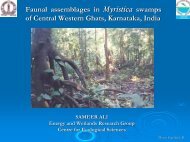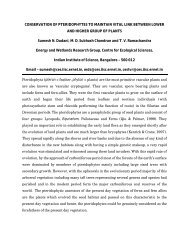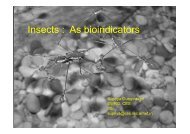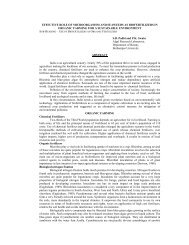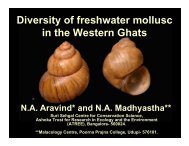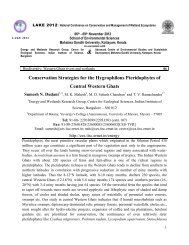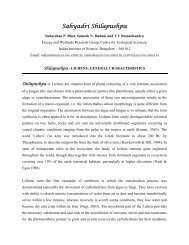a brief comp a brief comparison of modern pteridophyte arison of ...
a brief comp a brief comparison of modern pteridophyte arison of ...
a brief comp a brief comparison of modern pteridophyte arison of ...
Create successful ePaper yourself
Turn your PDF publications into a flip-book with our unique Google optimized e-Paper software.
112 Indian Fern Journal Volume XXVI (2009)<br />
Hauk et al. 2003, Little & Barrington 2003, Ranker et al. 2004, Geiger & Ranker 2005,<br />
Tsutsumi & Kato 2005, Zhang et al. 2005, Ebihara et al. 2006, Korall et al. 2006,<br />
Schuettpelz & Pryer 2007, Kirkpatrick 2007, Zhang et al. 2007, Kato & Tsutsumi 2008,<br />
Tsutsumi, Zhang & Kato 2008, Murdock 2008, Krier et al. 2008, Der et al. 2009). Most <strong>of</strong><br />
them state that their cladistic trees constitute the new classification <strong>of</strong> the ferns they have<br />
sampled as if there were no alternatives. After a wide-reaching study <strong>of</strong> chloroplast<br />
moleculology, Smith et al. (2006) put forward a new classification <strong>of</strong> <strong>pteridophyte</strong>s, which<br />
has been taken up as constituting the properly based revision <strong>of</strong> <strong>pteridophyte</strong> families<br />
superceding all previous schemes and is held by a number <strong>of</strong> Botanists to be the definitive<br />
work for present and future classification.<br />
There is indeed a general congruence between Smith’s classification and Kramer &<br />
Green’s taxonomic classification, though for reasons which are not always clear, but there<br />
are several minor and one or two major points <strong>of</strong> difference. However automatically<br />
accepting such a scheme and the other generic findings from related papers as correct<br />
taxonomically is fraught with problems. It might be more appropriate to see it as a possible<br />
alternative which needs fundamental new study, probably not yet entirely possible with<br />
present-day methodology, before it can be tested further as to its accuracy. Some <strong>of</strong> the<br />
more surprising findings might indeed indicate places where traditional morphological study<br />
could not readily supply answers so far, but it seems to the present author that the<br />
moleculological results still need verification by some other methods.<br />
One <strong>of</strong> the greatest drawbacks <strong>of</strong> such studies is that it is all placed in an<br />
unnecessary straightjacket <strong>of</strong> cladistic hypothesis - that taxa must be monophyletic, or clades.<br />
In a wider taxonomic context it is actually not necessary at all that taxa have to be<br />
monophyletic and both the almost universally common state <strong>of</strong> paraphyly (see Brummitt<br />
1996, 1997, 2001, 2006, Rieseberg & Brouillet 1994) and, in the present author’s opinion,<br />
apparent molecular polphyly are perfectly acceptable states, which are not as artificial as<br />
cladistic moleculologists believe them to be. In fact, along with many other taxonomists who<br />
have serious doubts about cladistic hypotheses, the present author is actually <strong>of</strong> the opinion<br />
that the whole <strong>of</strong> cladistic theory is not only a gross and obvious blunder <strong>of</strong> the "flat earth"<br />
type, but that it is also now propagated against common sense and all the odds as a kind <strong>of</strong><br />
<strong>comp</strong>ulsory neo-mythology - a cladistic delusion! Strict cladistic-moleculo adherence actually<br />
obstructs perfectly proper and meaningful morpho-taxonomic considerations from being<br />
balanced up with the molecular results prior to coming to a wider-based conclusion. "Genera"<br />
which are indistinguishable except by some very minor and insignificant character are surely<br />
best understood as not being genera at all, but some minor group within a more recognisable<br />
genus.<br />
Furthermore the significance <strong>of</strong> the molecular basis itself may be suspected <strong>of</strong> not<br />
being properly and fully understood at the present juncture. This applies particularly to<br />
sequences which are connected only with physiology and biochemistry, as opposed to



